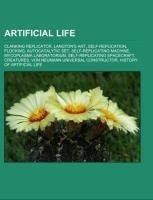
-
 Anglický jazyk
Anglický jazyk
Artificial life
Autor: Source: Wikipedia
Source: Wikipedia. Pages: 49. Chapters: Clanking replicator, Langton's ant, Self-replication, Flocking, Autocatalytic set, Self-replicating machine, Mycoplasma laboratorium, Self-replicating spacecraft, Creatures, Von Neumann universal constructor, History... Viac o knihe
Na objednávku, dodanie 2-4 týždne
16.11 €
bežná cena: 17.90 €
O knihe
Source: Wikipedia. Pages: 49. Chapters: Clanking replicator, Langton's ant, Self-replication, Flocking, Autocatalytic set, Self-replicating machine, Mycoplasma laboratorium, Self-replicating spacecraft, Creatures, Von Neumann universal constructor, History of artificial life, Weasel program, Grey goo, Sugarscape, Langton's loops, Turmite, Codd's cellular automaton, Noble Ape, Artificial creation, Tierra, Artificial chemistry, Avida, Digital organism, Darwinbots, Code of the Lifemaker, Astrochicken, Animat, Santa Claus machine, MASON, Boids, Sniffy, Artificial life organizations, Creatures 3, Creatures 2, Polyworld, Artificially Expanded Genetic Information System, DigiHive, Artificial life framework, Pacrat, Framsticks, Evolve 4.0, Synthetic Organism Designer, Synthetic Mycoides. Excerpt: A self-replicating machine is an artificial construct that is theoretically capable of autonomously manufacturing a copy of itself using raw materials taken from its environment, thus exhibiting self-replication in a way analogous to that found in nature. The concept of self-replicating machines has been advanced and examined by Homer Jacobsen, Edward F. Moore, Freeman Dyson, John von Neumann and in more recent times by K. Eric Drexler in his book on nanotechnology, Engines of Creation and by Robert Freitas and Ralph Merkle in their review Kinematic Self-Replicating Machines which provided the first comprehensive analysis of the entire replicator design space. The future development of such technology has featured as an integral part of several plans involving the mining of moons and asteroid belts for ore and other materials, the creation of lunar factories and even the construction of solar power satellites in space. The possibly misnamed von Neumann probe is one theoretical example of such a machine. Von Neumann also worked on what he called the universal constructor, a self-replicating machine that would operate in a cellular automata environment. A self-replicating machine is, as the name suggests, an artificial self-replicating system that relies on conventional large-scale technology and automation. Certain idiosyncratic terms are occasionally found in the literature. For example, the term "clanking replicator" was once used by Drexler to distinguish macroscale replicating systems from the microscopic nanorobots or "assemblers" that nanotechnology may make possible, but the term is informal and is rarely used by others in popular or technical discussions. Replicators have also been called "von Neumann machines" after John von Neumann, who first rigorously studied the idea. But this term ("von Neumann machine") is less specific and also refers to a completely unrelated computer architecture proposed by von Neumann, so its use is discouraged where accuracy is i
- Vydavateľstvo: Books LLC, Reference Series
- Rok vydania: 2012
- Formát: Paperback
- Rozmer: 246 x 189 mm
- Jazyk: Anglický jazyk
- ISBN: 9781157075882












